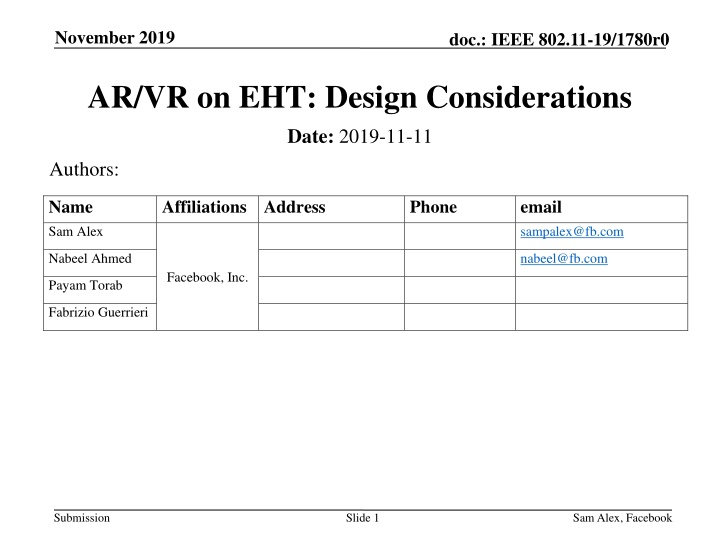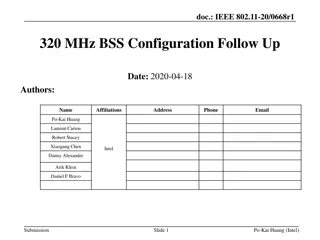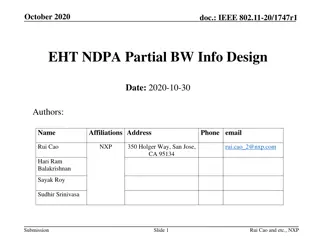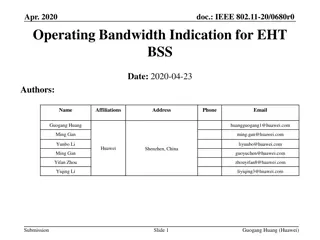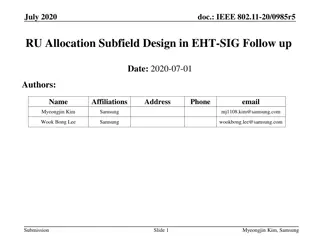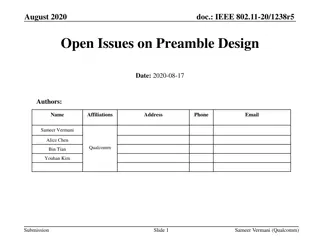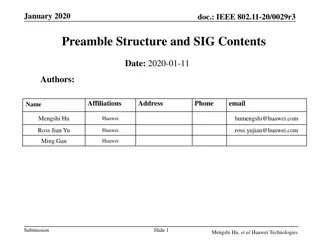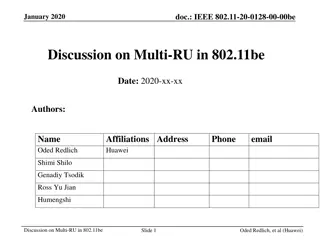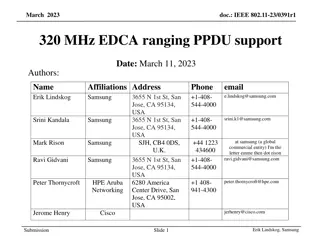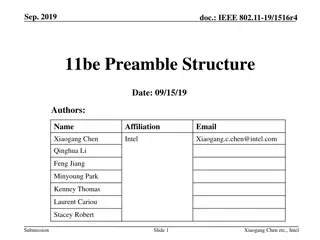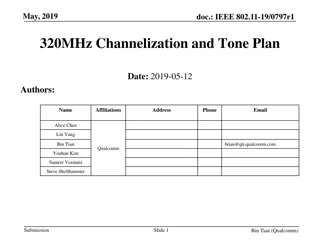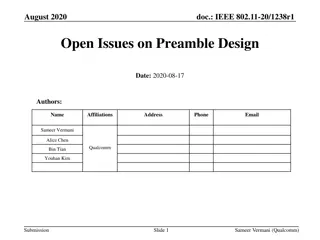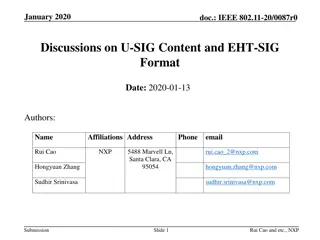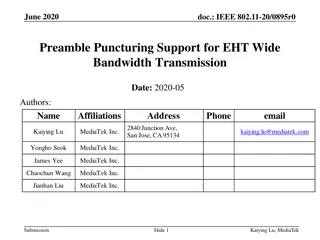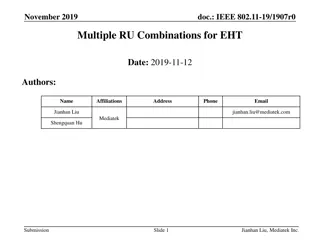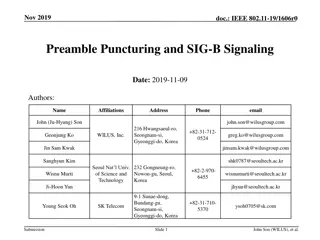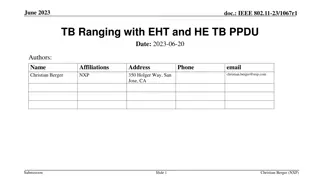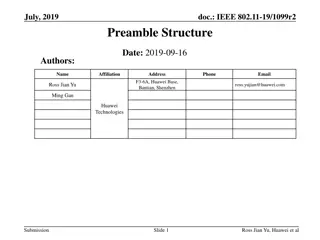Design Considerations for AR/VR on EHT in IEEE 802.11-19/1780r0
Explore the detailed design considerations and use cases for AR/VR applications on EHT in the IEEE 802.11-19/1780r0 document. The document covers various aspects such as KPIs, timing diagrams, simulation results, comparisons with 5GNR, source of latency in 802.11, and suggestions for optimizing performance. It also delves into key areas like high throughput, low latency, power consumption, and coexistence among multiple AR/VR links to meet the evolving demands of immersive technologies.
Download Presentation

Please find below an Image/Link to download the presentation.
The content on the website is provided AS IS for your information and personal use only. It may not be sold, licensed, or shared on other websites without obtaining consent from the author.If you encounter any issues during the download, it is possible that the publisher has removed the file from their server.
You are allowed to download the files provided on this website for personal or commercial use, subject to the condition that they are used lawfully. All files are the property of their respective owners.
The content on the website is provided AS IS for your information and personal use only. It may not be sold, licensed, or shared on other websites without obtaining consent from the author.
E N D
Presentation Transcript
November 2019 doc.: IEEE 802.11-19/1780r0 AR/VR on EHT: Design Considerations Date: 2019-11-11 Authors: Name Sam Alex Affiliations Address Phone email sampalex@fb.com Nabeel Ahmed nabeel@fb.com Facebook, Inc. Payam Torab Fabrizio Guerrieri Submission Slide 1 Sam Alex, Facebook
November 2019 doc.: IEEE 802.11-19/1780r0 Outline - Use cases - KPI/Timing diagram - Simulation results - Comparison with 5GNR - Source of Latency in 802.11 - Design Considerations - Few Suggestions - Straw poll Submission Slide 2 Sam Alex, Facebook
November 2019 doc.: IEEE 802.11-19/1780r0 Use Cases AR/MR VR P2P Router P2P Router (Rendering from phone or other device) (Enterprise rendering) (Remote rendering on PC) (Remote rendering on server) ISP Submission Slide 3 Sam Alex, Facebook
November 2019 doc.: IEEE 802.11-19/1780r0 KPIs Use Case VR P2P VR Router AR/MR Glasses Throughput >100Mbps >50Mbps >100Mbps Latency ~5ms ~2ms 2-5ms Power ~ 1W (HMD) ~ 1W (HMD) << 1W (Glass) High throughput - Traffic is primarily video post-compression. Periodic/deterministic traffic (1 burst per video frame) - Refresh rate: ~100Hz, Resolution: >4K (x2 eyes) Video frame latency objective at ~99.99 percentile - Downlink wireless added latency, measured as latency experienced by a frame while it transits the wireless subsystem - Overall motion to photon (M2P) latency target < 20ms. Almost lossless, Video frame reliability: ~99.99 percentile Power consumption - VR: sustained high throughput for ~ 1hour. - AR: whole day active Coex among multiple AR/VR links. Throughput down scaling in high density scenario Slide 4 - - - - - Submission Sam Alex, Facebook
November 2019 doc.: IEEE 802.11-19/1780r0 Typical timing diagram Pipelined architecture in order to minimize latency Either wireless link should be - allowed to transmit on demand (Instantaneous transmission) - or scheduled (wireless access locked to system time or system time locked to wireless schedule) - - Controller/Head pose Uplink POSE WIRELESS TXN Wireless added Latency < 5ms P9999 RENDER CPU/GPU Video Frame Downlink COMPRESSION WIRELESS TRANSFER DECOMPRESSION SCANOUT/DSIPLAY Frame Interval True Motion to Photon Latency (M2P) Submission Slide 5 Sam Alex, Facebook
November 2019 doc.: IEEE 802.11-19/1780r0 Meeting KPI KPIs can be easily met with 802.11 if channel is interference free Presence of other users in the same band causes large latency tail depending on the traffic condition - - X X VR USER MDU scenario (5x2x5) [1] Alternate apt. uses same channel 100Mbps desired, 10Mbps interferers No optimization Same AC among all users With optimization Preferential access for Low latency application - - - - - ~2 orders of magnitude latency improvement for VR user but almost NO (< 3%) impact to OBSS throughput performance Submission Slide 6 Sam Alex, Facebook
November 2019 doc.: IEEE 802.11-19/1780r0 Comparison between 5GNR and 802.11 802.11ax/be and 5GNR are competing technologies when it comes to meeting specs such as IMT2020 [2] or other KPIs - While the OFDM numerology (FFT size, symbol duration etc.) in 802.11 and immediate ACK favors low latency application, the CSMA/CA logic greatly impacts low latency performance in moderate to high density scenarios. - 5GNR has made a lot of headway relative to 802.11 in standardizing low latency constructs, because of the emphasis it put for those use cases. - 5GNR supports both QoS (~4ms) and URLLC (sub-ms latency) - URLLC pre-empts scheduled traffic to transmit low latency traffic instantaneously and out of turn, by puncturing the tones of the scheduled traffic. - Licensed operation might be a deterrent in terms of cost to support high bandwidth VR but features like D2D feature along with high spatial reuse might help in making the use case feasible. - Submission Slide 7 Sam Alex, Facebook
November 2019 doc.: IEEE 802.11-19/1780r0 Source of Wireless latency in 802.11 The source of latency can be classified under Protocol - Insufficient flexibility in channel access. - No provision for guaranteeing low latency. Limited TXOP duration for lower contention traffic tradeoff Inadequate protocol to coordinate among independent BSS Channel switching reliability and latency Collision between UL and DL (can be solved by triggering) Hardware/Implementation related - Recalibration related outages - Channel scanning - Packet reordering and stalling of northbound pipeline - ARQ retransmissions as opposed to using FEC codes (outer codes/erasure codes) - Head of line blocking, insufficient timeout/TTL control - Poor link adaptation and precoding (not tuned for quick motion or low latency). Typically these are optimized for throughput alone, not latency. - Cross layer adaptation, Queuing delay, software inefficiencies etc. Slide 8 - - - - Submission Sam Alex, Facebook
November 2019 doc.: IEEE 802.11-19/1780r0 Current techniques being considered for latency mitigation - Multilink - Techniques like multilink will help, but it is at the expense of burning more power (N PHY/MACs receivers operate in parallel) - Coordination - Coordination among BSS helps in reducing latency, but coordination should be extended to allow OTA coordination among independent BSS. Being independent implies that there is no guarantee device would participate in the coordination. However, some additional framework in the standards can help enforce this. - We need more than just the above features to enable low latency use cases. Submission Slide 9 Sam Alex, Facebook
November 2019 doc.: IEEE 802.11-19/1780r0 Some important considerations How will latencies comparable to those defined in 3GPP 5GNR be achievable with 802.11be in moderately congested scenario? - We require more deterministic (bounded) latency - How will we leverage the relatively new spectrum (6GHz) efficiently which need to support only 11ax/be and above protocol? - How will latency be lowered - without impacting proper operation of other links (CoEx with legacy)? - without impacting airtime fairness? - How multiple low latency links operating in the presence of each other? (CoEx with similar use cases) - Can they all simultaneously achieve low latency? In some cases, YES! - Submission Slide 10 Sam Alex, Facebook
November 2019 doc.: IEEE 802.11-19/1780r0 Suggestions: low latency techniques New access category [3] - Higher priority than AC-VO, minimize contention, avoid collision. No change to channel sensing, CCA etc. - High priority access for low latency devices could potentially result in increased collisions with regular data packets. This should be avoided as it results in degradation of achievable throughput and latency. - Collision with critical management frames Beacons, CSA etc. from OBSS should be avoided, in order to avoid disruption to OBSS links. - Defining a new IFS (call it low latency IFS LLIFS) is one scheme that can meet the requirements - For example, a transmission that starts between PIFS (25us) and DIFS (34us). i.e. PIFS<LLIFS<DIFS - No impact to Beacons and other PIFS based transmission. Better channel access than DIFS - No collision with packets using either of the two legacy IFS. - Ensures fairness in airtime by limiting duty cycle, for example - Ensure own airtime occupancy less that some threshold - Ensure overall (own + others) airtime less than some threshold Adaptively avoid 100% channel utilization - Like among other legacy ACs, there is no fairness in latency. - Submission Slide 11 Sam Alex, Facebook
November 2019 doc.: IEEE 802.11-19/1780r0 Suggestions: low latency techniques (cont ) Coordination among devices that use the new AC [4][5] - Share schedules among each other (Broadcast). Distributed and autonomous schedules No master. Common structure/rules to be defined for schedules. - Align transmissions among participating links, using over-the-air (OTA) sharing of TWT schedules among APs of independent BSS. Sufficient time synchronization accuracy is required to make sharing & usage of schedules feasible. - Perform OFDMA among independent BSS for additional flexibility. - Scheduling ensures that those devices that use LLIFS don t collide with each other in a catastrophic manner. Some regulatory mechanism can ensure that devices that use LLIFS will follow certain strict rules to prevent disruption to both legacy and low latency use case/applications. - Align upper layers to generate traffic in accordance with the agreed schedule, in order to pipeline effectively All devices achieve low latency simultaneously. - Independent BSS1 OTA coordination Independent BSS2 Submission Slide 12 Sam Alex, Facebook
November 2019 doc.: IEEE 802.11-19/1780r0 Straw Poll Do you support studying low latency techniques (like those shown in slides 11/12) in addition to those being currently studied as part of 802.11be? 1) Yes 2) No 3) Abstain Submission Slide 13 Sam Alex, Facebook
November 2019 doc.: IEEE 802.11-19/1780r0 References 1. 2. 3. 4. 11-14-0980 TGax Simulation Scenarios 11-18-0256-00-AANI-802-11ax-for-imt-2020 11-19-1524-00-00be-latency-enhancement-for-eht Latency reduction: 1. 11-19-1287-01-00be-tsn-support-in-802-11-and-potential-extensions-for-tgbe 2. 11-19-1207-04-00be-views-on-latency-and-jitter-features-in-tgbe Multi AP coordination 1. 11-17-0117-01-00ax-broadcast-twt-tim 2. 11-19-1019-00-00be-virtual-bss-for-multi-ap-coordination 3. 11-19-1117-02-00be-direct-link-mu-transmissions 5. Submission Slide 14 Sam Alex, Facebook
November 2019 doc.: IEEE 802.11-19/1780r0 Coordinated Scheduling among BSS Frame Interval COMPRESSION BSS/User #1 WIRELESS TRANSFER #1 DECOMPRESSION SCANOUT / DISPLAY COMPRESSION WIRELESS TRANSFER #2 BSS #2 User/ DECOMPRESSION SCANOUT / DISPLAY COMPRESSION BSS #3 User/ WIRELESS TRANSFER #3 DECOMPRESSION COMPRESSION BSS #4 User/ WIRELESS TRANSFER #4 DECOMPRESSION Wireless Schedule Basic unit Note: Subsystem schedules driven by wireless schedule Submission Slide 15 Sam Alex, Facebook
